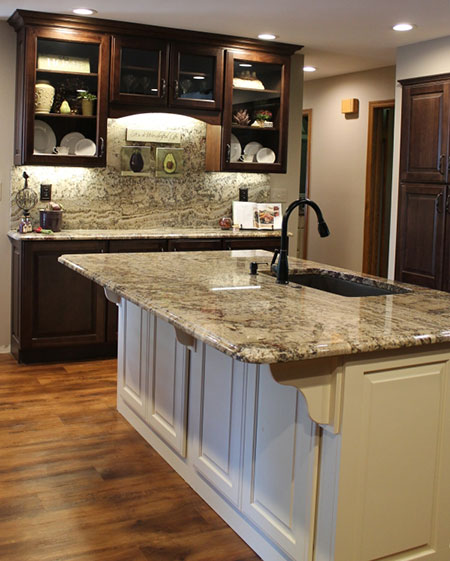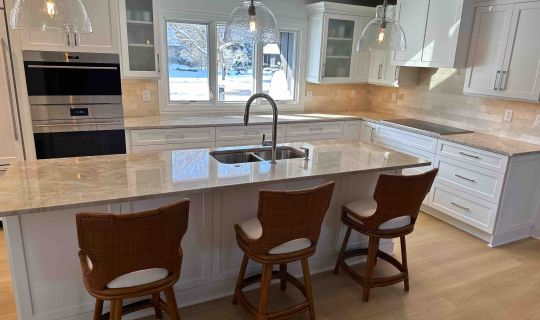Whether you are designing your countertops for the first time or redesigning for the tenth time, you will have presumably thought about the material you wish to use. Some of the top materials people turn to are granite and quartz. While both are aesthetically pleasing, durable, and excellent for countertops, what exactly is the difference? Below, we will touch on the various distinctions to help you choose which is best for your space.
First of all, it is important to understand the differences between the two stone materials. Granite is a very hard stone and is 100% natural. Granite is mined from various quarries all over the world, and is then cut down to a workable size and polished. Quartz, on the other hand, is not 100% natural, countertops are created using 95% ground natural quartz and 5% polymer resin.
Now that you know a bit about the materials you are working with, let's explore some of the other differences.
Appearance: Granite comes in a wide variety of colors and patterns. This is due to how granite is created – formed by magma cooling over centuries under intense pressure. Granite colors vary from something as simple as black (caused by an iron and magnesium rich rock called gabbro) or white (due to alabaster in the granite), to more custom slabs in red/pink (caused by potassium feldspar or iron oxide) or blue (due to larkivite and labradorite). Other colors are also available depending on your remodeling design. Some slabs also have unique mineral inclusions, such as lava stone, silica, feldspar, quartz, etc., and you can be assured that no two pieces are the same. There are almost endless choices to pick from for your particular needs.
Quartz has become so popular because while it looks like stone, it is more customizable for your design purposes. Where granite offers almost unlimited options for colors and patterns, you may have to search for the perfect piece of quartz to complement your color scheme. Many feel this makes the quartz selection process easier.
Environmentally Friendly: Because granite is mined from quarries, people who are environmentally conscious need to be aware that mining requires a lot of energy and, depending on where your quartz is sourced from, ample transportation. To cut down on transportation, try using native stone, or visit salvage shops for pieces that can be altered to fit your design.
Quartz is an engineered stone, and therefore is thought to be more environmentally friendly than granite. If you are using a stone that is locally made, it also cuts down on the transportation.
 Maintenance: Both surfaces need to be cleaned daily with soap and water or a household cleaner, especially if you have spilled anything, as both of these materials will stain. However, to ensure that your granite countertops stay beautiful, you will want to have them resealed once a year. You can seal your granite countertops yourself. To see if resealing is needed, squeeze a few drops of water onto your countertop and wait 15 minutes. If the drops are still beaded, you do not need to reseal. Sealing your counter too often can cause a haze or discoloration. If you do need to reseal your countertop, follow the granite resealing directions we provide in our blog.
Maintenance: Both surfaces need to be cleaned daily with soap and water or a household cleaner, especially if you have spilled anything, as both of these materials will stain. However, to ensure that your granite countertops stay beautiful, you will want to have them resealed once a year. You can seal your granite countertops yourself. To see if resealing is needed, squeeze a few drops of water onto your countertop and wait 15 minutes. If the drops are still beaded, you do not need to reseal. Sealing your counter too often can cause a haze or discoloration. If you do need to reseal your countertop, follow the granite resealing directions we provide in our blog.
Because quartz is engineered, it does not need to be resealed, so the maintenance is very low and a simple washing is generally sufficient.
Durability: Granite is extremely durable and is resistant to heat and most other aspects of normal kitchen wear and tear. However, be aware that because granite is a porous surface, it can stain if spills aren't tended to quickly. Also, damage can occur if the countertop receives any sort of intense blow.
Many people assume that because granite is natural, it would be harder than quartz, but that is not the case. Quartz is actually harder and more durable than granite. It is said that quartz is practically indestructible. Also, keep in mind that quartz isn't porous, so it is easier to keep clean and hygienic. Do be careful with heat though; quartz can be damaged by excessive heat, so be sure to use heating pads with all of your pans.
No matter which material you choose for your space, contact us today to discuss your options for size, color and design features!



